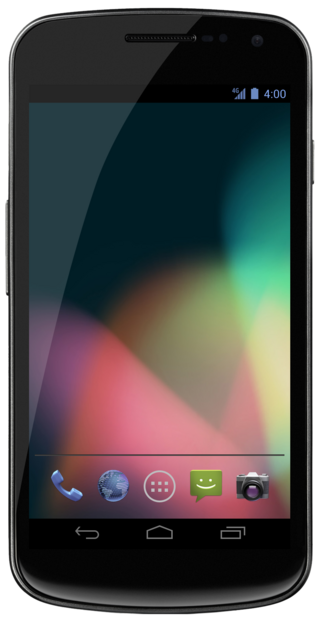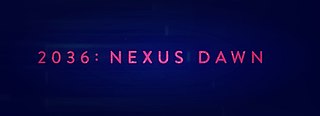Nexus 7 is a series of Android-based mini tablet computers co-developed by Google, and may refer to:
- Nexus 7 (2012), the first generation
- Nexus 7 (2013), the second generation
Nexus 7 is a series of Android-based mini tablet computers co-developed by Google, and may refer to:
Nexus is a Latin word for connection, usually where multiple elements meet. It may refer to:

The Mazda Savanna is a rotary-powered automobile sold by the Japanese manufacturer Mazda between 1971 and 1978. Between 1978 and 1991, spanning two generations, Mazda sold the Savanna replacement as the Mazda Savanna RX-7. Mazda exclusively used the Savanna nameplate in Japan. It was exported as the Mazda RX-3 in its first generation from 1971 to 1978, and as the Mazda RX-7 in its subsequent generations.
NEX or Nex may refer to:
Google phone may refer to:
Google Nexus is a discontinued line of consumer electronic devices that run the Android operating system. Google managed the design, development, marketing, and support of these devices, but some development and all manufacturing were carried out by partnering with original equipment manufacturers (OEMs). Alongside the main smartphone products, the line also included tablet computers and streaming media players; the Nexus started out in January 2010 and reached its end in October 2016, replaced by Google Pixel.
The version history of the Android mobile operating system began with the public release of its first beta on November 5, 2007. The first commercial version, Android 1.0, was released on September 23, 2008. The operating system is developed by Google on a yearly cycle since at least 2011. New major releases are announced at Google I/O along with its first public beta to supported Google Pixel devices. The stable version is then released later in the year.

The Galaxy Nexus (GT-I9250) is a touchscreen Android smartphone co-developed by Google and Samsung Electronics. It is the third smartphone in the Google Nexus series, a family of Android consumer devices built by an original equipment manufacturer partner. The phone is the successor to Google's previous flagship phones, the Nexus One and Nexus S.

Nexus Q was a digital media player developed by Google. Unveiled at the Google I/O developers' conference on June 27, 2012, the device was expected to be released to the public in the United States shortly thereafter for US$300. The Nexus Q was designed to leverage Google's online media offerings, such as Google Play Music, Google Play Movies & TV, and YouTube, to provide a "shared" experience. Users could stream content from the supported services to a connected television, or speakers connected to an integrated amplifier, using their Android device and the services' respective apps as a remote control for queueing content and controlling playback.

The first-generation Nexus 7 is a mini tablet computer co-developed by Google and Asus that runs the Android operating system. It is the first tablet in the Google Nexus series of Android consumer devices marketed by Google and built by an original equipment manufacturer partner. The Nexus 7 features a 7.0-inch (180 mm) display, an Nvidia Tegra 3 quad-core chip, 1 GB of RAM, Wi-Fi and NFC connectivity, and 8, 16 or 32 GB of storage. The tablet was the first device to ship with version 4.1 of Android, nicknamed "Jelly Bean". By emphasizing the integration of the Google Play multimedia store with Android 4.1, Google intended to market the Nexus 7 as an entertainment device and a platform for consuming e-books, television shows, films, games, and music.

The Nexus 10 is a tablet computer co-developed by Google and Samsung Electronics that runs the Android operating system. It is the second tablet in the Google Nexus series, a family of Android consumer devices marketed by Google and built by an OEM partner. Following the success of the 7-inch Nexus 7, the first Google Nexus tablet, the Nexus 10 was released with a 10.1-inch, 2560×1600 pixel display, which was the world's highest resolution tablet display at the time of its release. The Nexus 10 was announced on October 29, 2012, and became available on November 13, 2012.

The Nexus 6 is a phablet co-developed by Google and Motorola Mobility that runs the Android operating system. The successor to the Nexus 5, it is the sixth smartphone in the Google Nexus series, a family of Android consumer devices marketed by Google and built by an original equipment manufacturer partner. Nexus 6 and the HTC Nexus 9 served as the launch devices for Android 5.0 "Lollipop".
Google Pixel is a brand of portable consumer electronic devices developed by Google that run either ChromeOS or the Android operating system. The main line of Pixel products consist of Android-powered smartphones, which have been produced since October 2016 as the replacement of the older Nexus, and of which the Pixel 8 and 8 Pro are the current models. The Pixel brand also includes laptop and tablet computers, as well as several accessories, and was originally introduced in February 2013 with the Chromebook Pixel.

The second-generation Nexus 7, also commonly referred to as the Nexus 7 (2013), is a mini tablet computer co-developed by Google and Asus that runs the Android operating system. It is the second of three tablets in the Google Nexus tablet series, the Nexus family including both phones and tablets running essentially stock Android which were originally marketed for developer testing but later marketed by Google to consumers as well, all of which were built by various original equipment manufacturer partners. Following the success of the original Nexus 7, this second generation of the device was released on July 26, 2013, four days earlier than the originally scheduled date due to early releases from various retailers. The tablet was the first device to ship with Android 4.3.

Nexus 5 is an Android smartphone sold by Google and manufactured by LG Electronics. It is the fifth generation of the Nexus series, succeeding the Nexus 4. It was unveiled on October 31, 2013 and served as the launch device for Android 4.4 "KitKat", which introduced a refreshed interface, performance improvements, greater Google Now integration, and other changes. Much of the hardware is similar to the LG G2 which was also made by LG and released earlier that year.

The Nexus 9 is a tablet computer co-developed by Google and HTC that runs the Android operating system. It is the fourth tablet in the Google Nexus series, a family of Android consumer devices marketed by Google and built by an OEM partner. The device is available in two storage sizes, 16 GB for US$399 and 32 GB for US$479. Along with the Nexus 6 mobile phone and Nexus Player digital media device, the Nexus 9 launched with 5.0 Lollipop, which offered several new features, notably a modified visual appearance, and the complete replacement of the Dalvik virtual machine with ART. Google has included an additional step to "Enable OEM unlock" before users can unlock the Nexus 9 bootloader.

Android Lollipop is the fifth major version of the Android mobile operating system developed by Google and the 12th version of Android, spanning versions between 5.0 and 5.1.1. Unveiled on June 25, 2014 at the Google I/O 2014 conference, it became available through official over-the-air (OTA) updates on November 12, 2014, for select devices that run distributions of Android serviced by Google. Its source code was made available on November 3, 2014. The first phone with Android Lollipop was the Nexus 6.

Nexus 6P is an Android smartphone developed and marketed by Google and manufactured by Huawei. It succeeded the Nexus 6 as the flagship device of the Nexus line of Android devices by Google. Officially unveiled on 29 September 2015 along with the Nexus 5X at the Google Nexus 2015 press event held in San Francisco, it was made available for pre-order on the same day in United States, United Kingdom, Ireland, and Japan.

2036: Nexus Dawn is a 2017 American short film acting as a prequel to the feature film Blade Runner 2049. It is one of three such prequels, alongside Blade Runner Black Out 2022 and 2048: Nowhere to Run. The short was released on August 30, 2017, approximately five weeks before the release of the feature film, and features Jared Leto as Blade Runner 2049 character Niander Wallace, alongside Benedict Wong. The film was written by Hampton Fancher and Michael Green, who also wrote the feature film, and directed by Luke Scott, whose father Ridley Scott directed the original Blade Runner and is executive producer on the sequel Blade Runner 2049.
The iPhone SE is a series of lower-cost smartphones, part of the iPhone family designed by Apple. It may refer to: